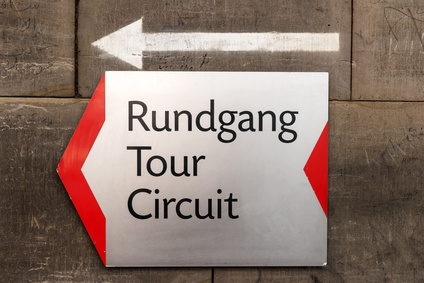Museum & Exhibition Visitor Studies with Eye Tracking

For many museums and exhibitions the principle of customer orientation is today’s key success factor and for that reason a part of contemporary museum work.
We provide visitor satisfaction tests and optimise the customer experience for museums and exhibitions.
It is not only important to know if visitors are satisfied or not on a yes/no scale.
To be able to conduct improvements it is necessary to know more detail about the visitor´s experience, to see everything in the visitor’s perspective to get a clue which factors contribute to a positive or negative visitor experience. Only by knowing the points of failure, improvement measures can be developed for enhancing the museums experience.
For this, we use special methods that combine eye tracking and qualitative interview.
Eye tracking
Eyetracking can measure which elements call attention and the sequence of the perception. We find out, how visitors make visual decisions and analyse how they can steer them.
Eyetracking allows an objective review of what the visitor has seen and read. Instead of an interview question like “Was the accompanying text of the exhibit X read?”, which many visitors will not remember anymore, the eyetracking data can be evaluated directly.
- whether the visitor looked at the exhibit (possibly even unconsciously)
- whether the visitors did read the accompanying text or not
- how long and intensively an exhibit was viewed
Examples of factors of the visitor experience
Before the visit:
- What expectations and ideas exist before visiting the museum (mental model), such as the scope of the exhibition, relevance to the presence and interactivity.
Orientation:
- Can the visitors orientate themselves independently in the museum or the exhibition without any help? Do any uncertainties or confusions occur?
- Does the signage comply with quality criteria for signage systems (e.g. font, contrast, positioning of the text, placing height, lighting etc.)?
- What are potential weaknesses of guidance systems? Where do visitors get disoriented or cannot continue without help?
- Are there areas in the museum / exhibition that do not catch much attention? We find out what the reasons are!
Education and mediation
- Is the shown information comprehensible?
- Is the language of the visitor spoken?
- Which visitors use which offer?
- Are certain productions understood?
Readability, comprehensibility
- Is the signage of the guidance system read and understood?
- What is read, what is not and why?
- Are the descriptions of the exhibits assigned correctly?
- Where communication elements are expected?
Structure and sequence
- Do the various theme worlds get perceived and understood?
- Is the sequence (e.g. numbering, annual figures) comprehensible and does it get visited in the “right order”?
Interactivity
- Do interactive elements get recognised as interactive and are they used? E.g. touchscreens, kiosk systems etc.
- Are the interactive elements user-friendly and contribute to a positive user experience?
After the visit/general/satisfaction
- What is the overall impression of the exhibition?
- How high is the satisfaction with the exhibition? Was the exhibition worth the visit?
- How was the experience compared to the visitors expectations?
- Will the visitor recommend a visit to the museum?
- Do visitors have a positive costumer experience?
- Is the visit of the museum fun? Is it educational, interesting and informative?
- What was remembered?
- Which main messages were conveyed?
Brochures and Guidelines
- Do visitors prefer printed general plans or synoptic tables?
- Do folders get accepted?
- Do they have a suitable format?
- Are print materials useful and helpful?
Procedure
The test subjects are recruited directly before the visit of the museum/exhibition in front of the entrance/the parking spaces/the foyer. As an incentive the participants get e.g. free entrance for the museum or vouchers or cash.
Then the test subjects are equipped with eye tracking glasses. The participants visit the exhibition while an experienced moderator accompanies and asks questions at critical points. After the visit an interview (structured depth interview) is conducted. The questions of the qualitative interview will be tailored to the specific exhibition and to the needs of our customer. Any data can be gathered, like e.g. friendliness of the museum staff, price-performance ratio, article-selection in the shop etc.
The tests are recorded by means of special eye tracking software: Everything the visitor sees and the visitor´s eye gaze are recorded. The visitor’s way through the exhibition/museum will be retrospectively analysed.
Result
The study shows in detail, which problem areas exist and which improvement measures are necessary. All problem areas get surveyed and classified according priority. Concrete suggestions for the optimisation of the guidance system will be developed.
Examples of recommendations
- • Concrete suggestions for the optimisation of the guidance system (picture language, signs, etc.)
- • Concrete suggestions for the improvement of the way finding solution: Where should the signs/directions be positioned and in which form?
- • Design recommendations for the signage: positioning, font, amount of information etc.
- • Which icons should be used?
- • How should the visitor guidance occur?
- • What size does the labelling need to have to be seen?
- • Should floor markings be used, if so where should they be positioned?
- • Should a colour coding system be used, and if so how should it be applied?
- • Design recommendations for interactive systems.
Front-end Evaluation
As in many other areas, it is more cost-effective to make improvements and optimisations during the development of a new conception, as after the inauguration. In formative evaluation an early prototype is tested and continuously improved until the results are satisfying. This prototyping can refer to only one individual exhibit – e.g. interactive elements – to parts or the whole exhibition.
We're here for you!
- Contact form
- office[at]usability.at
- +43 1 280 60 17
Our Customers








